Here are the 3 main types of dentures
- Complete or full dentures are for those patients who have lost all of their teeth on either or both of the arches. These take some time to get used to as their adjustment depends on a number of factors like the oral cavity muscles, saliva, bone & tongue.
- Removable or partial dentures are used to correct gaps when only few of the teeth are missing. These dentures are fastened to the natural teeth using metal attachments. Partial dentures help in maintaining tooth alignment by preventing the other natural teeth from shifting out of position.. There are different kinds of removable dentures - Acrylic, cast metal and valplast to name a few.
- Immediate dentures as the name suggests are placed at once, right after the patient gets his tooth extraction done. Adjustments are done once the healing process has completed.
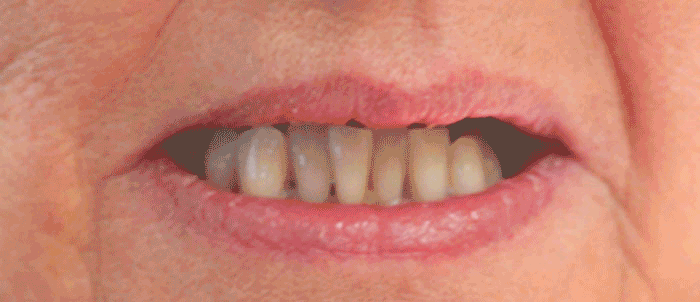
Right for you?
Millions of people lack some or all of their teeth. Resulting problems aren’t limited to poor appearance. Missing teeth make it difficult to chew food or even to speak. Muscles lose elasticity and the face begins to sag. The simple smile—a primary way to engage with others--may become impossible. No one should suffer this way today.
If you’re missing teeth for any reason, come and see us at Milford Dentists. The dentist will evaluate you for dentures. Other options for replacing missing teeth are Dental Bridges or Dental Implants. Have a look at our Missing Teeth page for more details. Many patients say they wish they’d taken this step earlier. They couldn’t believe they waited so long and relish their newfound confidence and comfort.
Existing dentures
Did you know dentures should be replaced every three to five years? The gums and ridges of your mouth change over time. Dentures, on the other hand, stay the same. For that reason wearing the same dentures over the course of years—particularly ill-fitting ones—can cause ridges to shrink. Unfortunately, some of these changes in the mouth and gums will be irreversible, making it that much more difficult to create dentures that fit well in the future. That’s why it’s important to have an ongoing relationship with a dentist who can ensure your dentures are properly adjusted—and keeping you healthy.
Acquiring dentures — what to expect
The process of getting dentures generally takes place over a few weeks. At the beginning, your mouth is studied and measured through means of models or impressions, in order to ensure pinpoint accuracy. At the next visits shape and colour will be carefully assessed. Finally your dentist precisely adjusts and places the completed denture. The dentist will take time to ensure the dentures look natural and feel comfortable.
You may experience temporary soreness, increased saliva flow, and difficulty swallowing or speaking. These sensations will subside as your muscles and tissues rapidly acclimate to the new dentures.
Care and cleaning
The upkeep and maintenance of dentures is simple. But it’s important to clean them every single day. Soft tooth brushes should be used, and warm water, not hot, to prevent warping. Economical electrosonic denture baths and specialty cleaning products are also helpful.
Dentures should be cared for over a partially filled sink or soft towel; this minimizes damage in the event they are accidentally dropped.
Conventional dentures are removable, however there are many different denture designs, some which rely on bonding or clasping onto teeth or dental implants.
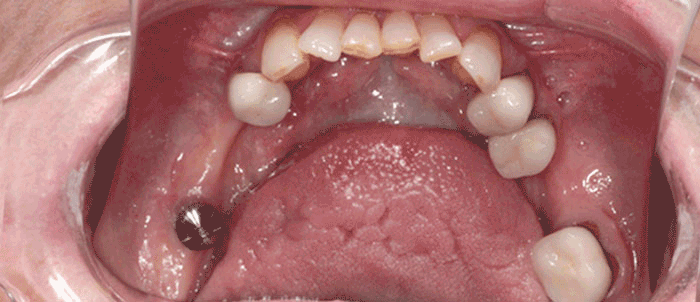
The super structure of dentures are made out of several materials-
Valplast
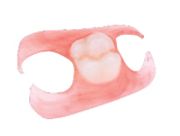
Valplast® is a flexible denture base resin which is ideal for partial dentures and unilateral restorations. The resin is a biocompatible nylon thermoplastic with unique physical and aesthetic properties. Valplast® allows your patient’s natural tissue tone to appear through the material. These dentures are very robust & are not prone to breaking. Because this fantastic material is flexible the gum colored ”wings” hook around adjacent teeth holding the denture in the “gap” snuggly & more securely than alternative denture materials such as acrylic. Valplast® dentures can be religned & also adjacent teeth can be added to an existing denture should this be required.
Acrylic
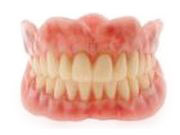 This pink plastic denture base is brittle.It is used to make standard full dentures & partial dentures. The largest single advantage to this type of denture (aside from its comparatively low cost) is that new teeth and new denture base can easily be added to an existing acrylic denture. These are frequently fabricated even if the remaining teeth have existing decay or periodontal disease and their prognosis is doubtful. If later in the course of treatment existing natural teeth are extracted for any reason, new false teeth can be added quickly to the partial, maintaining the patient’s appearance. In spite of the fact that they are considered a temporary solution, many people keep this type of appliance for many, many years, because as long as they are properly maintained, they look outwardly as good.
This pink plastic denture base is brittle.It is used to make standard full dentures & partial dentures. The largest single advantage to this type of denture (aside from its comparatively low cost) is that new teeth and new denture base can easily be added to an existing acrylic denture. These are frequently fabricated even if the remaining teeth have existing decay or periodontal disease and their prognosis is doubtful. If later in the course of treatment existing natural teeth are extracted for any reason, new false teeth can be added quickly to the partial, maintaining the patient’s appearance. In spite of the fact that they are considered a temporary solution, many people keep this type of appliance for many, many years, because as long as they are properly maintained, they look outwardly as good.
Chrome cobalt or titanium with either valplast or acrylic
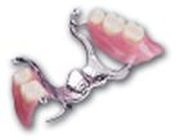 The underlying, mostly hidden, metal base increases the strength of the denture. These two types of metal can also be made very thin, making the joins from one side of the mouth to the other a lot less bulky.
The underlying, mostly hidden, metal base increases the strength of the denture. These two types of metal can also be made very thin, making the joins from one side of the mouth to the other a lot less bulky.
Milford Dentists your local denture dentists
Dentures
A denture is a removable appliance that replaces missing teeth and surrounding tissue. In the past dentures usually fit poorly. They were bulky and often painful. Today’s technology has brought remarkable improvement. Innovations in dentistry combined with modern light-weight materials mean current dentures are not only comfortable they closely resemble natural teeth